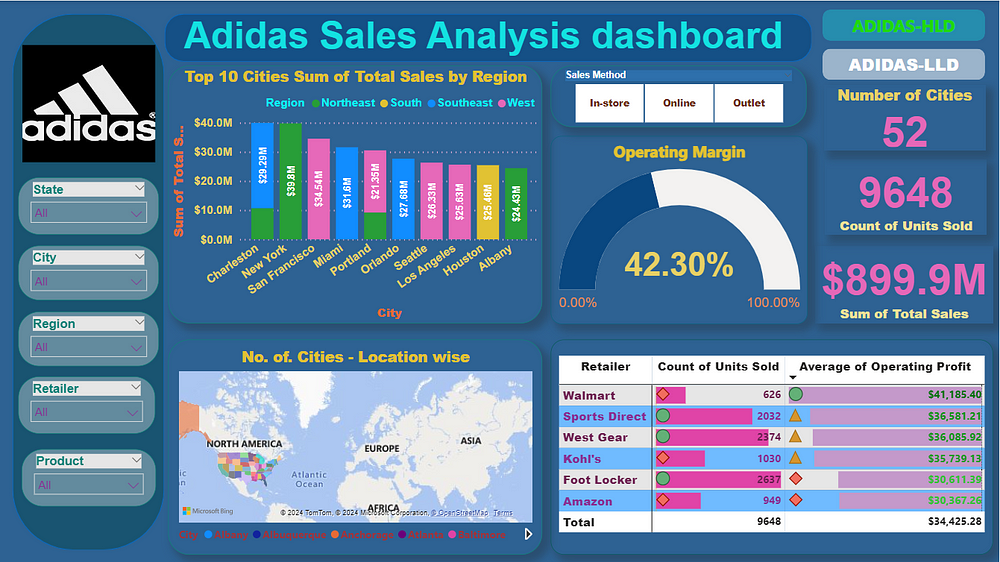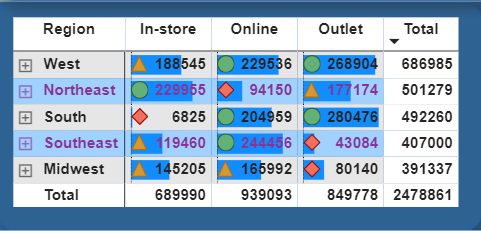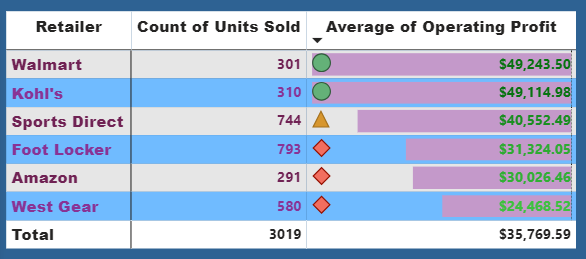
A Data Analysis Project — Adidas Sales Report.
Last Updated on March 13, 2024 by Editorial Team
Author(s): Kamireddy Mahendra
Originally published on Towards AI.
Data-driven insights are the new currency of business. — Martha Stewart.

As a data analyst, we should present the insights from the given data to stakeholders who will be involved in such a way that they can easily understand in a short interval of time. We should provide comprehensive insights into the sales performance and identifying actionable recommendations and sharing them with stakeholders is the actual goal of data analysts.
Here’s how I can structure the presentation:
Introduction about the data given
We need to understand the dataset given, and given filed parameters or filed columns including Retailer, Retailer ID, Invoice Date, Region, State, City, Product, Price per Unit, Units Sold, Total Sales, Operating Profit, Operating Margin, and Sales Method.
As data analysts, we must examine various filed parameters in the data set given as mentioned above, and that gives us an idea of how retailers are selling products across different regions, states, and cities, employing diverse sales methods.
Our role is to analyze sales performance across various locations and sales approaches for each retailer.
By doing so, we can provide actionable recommendations aimed at enhancing profitability and resolving any sales-related challenges or lingering issues within the business operations.
Finding Overall Sales Performance
- We need to provide an overview of total sales over the given cities and the period as shown in the figures below.
- Highlighted significant trends or patterns in total sales amount.
- I have shown a few visualizations such as line charts and bar graphs to illustrate these trends.


By looking at these two visuals we can understand in which city sales have been higher and lower and their respective regions as shown in the bar graph above.
The line chart shows which months and years the sales were low and high.
Regional Analysis
- We can see the sales performances by region, as you can see in the visual below, which shows the highest sales count and the lowest sales count concerning their regions.
- We can compare sales figures between different regions to identify them as high-performing and low-performing regions.
- We can suggest potential strategies for targeting specific regions based on their performance. As we can see the lowest sales were in the mid-west region we need to implement some techniques to improve the sales in this region.

Product Analysis
- We can also analyze sales performance for each product category in different regions.
- We can Identify top-selling products and underperforming products in their regions and I have shown with some symbols like their sales are low, steady, and increasing.
- We can evaluate the contribution of each product to total sales revenue, which you can also observe in the image below.
- We should recommend some adjustments to product offerings or marketing strategies based on product performance.

Sales Method Comparison
- We will compare sales performance across different sales methods (e.g., online sales, in-store sales, Outlet sales).
- Determined which sales method is most effective in generating more revenue and which one is less. Here, in-store sales are lower, and online sales are high. You can observe those in the image below.
- We need to Investigate any discrepancies between sales methods so that we will have a chance to improve their sales as well.
- We as a data analyst will propose some optimization strategies for improving sales effectiveness across all methods.

Profitability Analysis
- We should assess operating profit and operating margin for the entire data.
- We need to identify factors influencing profitability, such as pricing strategies or operational costs.
- We need to highlight areas where profitability can be improved, such as cost reduction or pricing optimization.
- Finally, we will provide recommendations for maximizing profitability while maintaining sales growth.

Forecasting and Predictive Analysis
- We should utilize historical sales data to generate forecasts for future sales.
- We should assist data scientists and those who will incorporate predictive modeling techniques to anticipate demand fluctuations or market trends in the future.
- We as a data analyst should offer insights into potential risks and opportunities based on forecasted sales trends as shown in the image.
- We also need to suggest strategies for adapting to forecasted changes in market conditions.

Conclusion and Recommendations
- In the end, as a data analyst, we should summarize key findings and insights from the entire data analysis.
- We should highlight actionable recommendations and as mentioned above for the client based on the identified insights.
- We should also emphasize the importance of data-driven decision-making in driving business more successful way.
- We also need to encourage ongoing monitoring and analysis of sales performance to inform strategic decision-making to the stakeholders of an organization.
I have added all the dashboard visuals for your reference so that you can understand the full picture of Adidas' sales analysis.

By following this structured approach, we can effectively communicate the insights derived from the dataset and provide valuable insights and recommendations to our clients or stakeholders for improving sales performance and running their overall business toward success.
Click Here to check the entire project file on my GitHub profile.
I hope this article helps the way to do data analysis and how to proceed to do data analysis to extract many insights from the data.
Support me by clapping or by giving feedback, which helps me to work on delivering quality content and it gives me motivation to move forward to share more valuable and useful content.
Follow me to catch any updates from me.
Thank you 🙂
Join thousands of data leaders on the AI newsletter. Join over 80,000 subscribers and keep up to date with the latest developments in AI. From research to projects and ideas. If you are building an AI startup, an AI-related product, or a service, we invite you to consider becoming a sponsor.
Published via Towards AI
Take our 90+ lesson From Beginner to Advanced LLM Developer Certification: From choosing a project to deploying a working product this is the most comprehensive and practical LLM course out there!
Towards AI has published Building LLMs for Production—our 470+ page guide to mastering LLMs with practical projects and expert insights!

Discover Your Dream AI Career at Towards AI Jobs
Towards AI has built a jobs board tailored specifically to Machine Learning and Data Science Jobs and Skills. Our software searches for live AI jobs each hour, labels and categorises them and makes them easily searchable. Explore over 40,000 live jobs today with Towards AI Jobs!
Note: Content contains the views of the contributing authors and not Towards AI.














